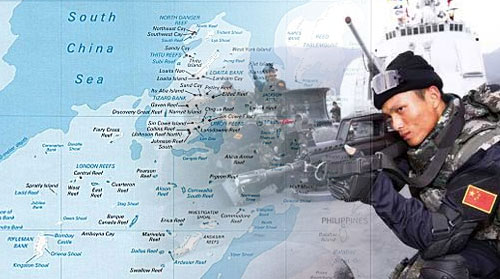Editor’s Note: The race to secure natural resources in the South China Sea has only just begun, argues NAM contributor Thi Lam, and long-simmering territorial disputes over the oil-rich Spratly islands between Southeast Asian nations and a newly assertive China are intensifying. Deterrence, he says, may hold the key to resolving the crisis.

When it comes to geopolitics, especially in the South China Sea, there’s a time for détente and then there’s a time for deterrence.
On May 26, a Chinese vessel, part of that country’s Marine Surveillance Unit – an organization created in 1998 to oversee activities within China’s self-defined Exclusive Economic Zone – cut the cable of a Vietnamese gas exploration ship operating within Vietnam’s territorial waters. This blatant violation of the 1982 United Nations Charter on the Law of the Seas added to a persistent pattern of Chinese expansionism in the region: occupation of the Paracel Islands in 1974 and of the Spratly archipelago in 1979, as well as the acquisition of 12,000 square kilometers of territorial waters in the Gulf of Tonkin conceded by Hanoi under a pact signed in 2000.
China’s claims on the rich gas field near the Natuna Islands, 400 miles northeast of Sumatra, Indonesia, and its dispute with Japan over the Senkaku Islands in the East China Sea, nearly set off a regional crisis in the 1990s.
The Association of Southeast Asian Nations (ASEAN) is too weak and too divided to present a united front to China’s aggressiveness. Vietnam, Cambodia and Laos, for instance, are more or less subservient to China, while the Philippines, Thailand and Indonesia have strong military ties with the United States.
Moreover, China’s self-serving dispute settlement policy calls for bilateral negotiations – in which it can bring about its overwhelming power to intimidate and bully weaker negotiating partners. This “divide and conquer” strategy has left ASEAN in the cold and hindered its ability to manage regional disputes involving member states.
The United States, meanwhile, continues to monitor political and military developments in the South China Sea. Secretary of State Hillary Clinton affirmed as much during the ASEAN Regional Forum in Hanoi in July 2010, reiterating America’s “national interest” there and calling for a regional solution. On a visit to Beijing on July 10, Joint Chiefs of Staff Chairman Admiral Mike Mullen restated Washington’s determination to maintain a long-term presence in the region; he also expressed concern that barring a resolution, the crisis could trigger a regional conflict with unpredictable consequences.
Backing up these statements have been U.S. naval activities in the area; including joint exercises with the navies of South Korea, Vietnam and the Philippines, the latter two countries being actively involved in territorial disputes with China over the oil-rich Spratly islands.
Naval maneuvers and political posturing, however, will not likely deter China from pursuing its expansionist policy. A strong international organization with the backing of military force might. In the view of certain geopolitical strategists, the resurrection of the now-defunct Southeast Asia Treaty Organization (SEATO) would be required to thwart this new Chinese threat.
Established in 1955 to provide for the collective defense of Southeast Asia and to block communist expansion in the region, SEATO was modeled on the North Atlantic Treaty Organization (NATO), with member states employing their militaries in the defense of fellow SEATO nations. Although SEATO did provide a legal framework for the U.S. intervention in the Vietnam War, historians came to regard it as a failure for its internal disagreements and lack of joint military structure, preventing the group from effectively fulfilling its mission.
A more immediate and viable option is to expand NATO, whose forces were engaged in the Korean War, and are being deployed in Iraq and Afghanistan today. In another context, NATO’s successful containment of the Soviet Union during the Cold War bought time for Western powers to bring other assets to bear on the former USSR, liberating millions of people in Eastern Europe from Communist oppression.
The war over natural resources and energy has only just begun and is predicted to intensify in the coming decades. Countries ill equipped to defend their interests will be at a great disadvantage in the long run.
History teaches that appeasement without teeth only encourages aggression. “Detente without deterrence,” wrote President Richard Nixon, who possibly knew China better than any other US president — “leads to appeasement, and deterrence without detente leads to unnecessary confrontation.”
But because China’s autocratic communist regime knows only the language of force when it comes to the South China Sea, and because of the high stakes involved in the strategic Western Pacific region, it may be better to threaten deterrence – even at the cost of detente – than to offer detente without the will for deterrence.
Thi Quang Lam
Jul 26, 2011
Thi Quang Lam is a former general in the South Vietnamese Army and the author of “The Twenty-Five Year Century: A South Vietnamese General Remembers the Indochina War to the Fall of Saigon” and “Hell in An Loc: the 1972 Easter Invasion and the Battle that Saved South Vietnam”











































One Comment
hemp
06 15 2011 14 08CHINA VIETNAMSouth China Sea Beijing excludes the use of force but warns USBeijing tries to reduce tensions with Vietnam and the Philippines urging them to do more for peace and stability . China warns that internationalising the issue will make matters worse.